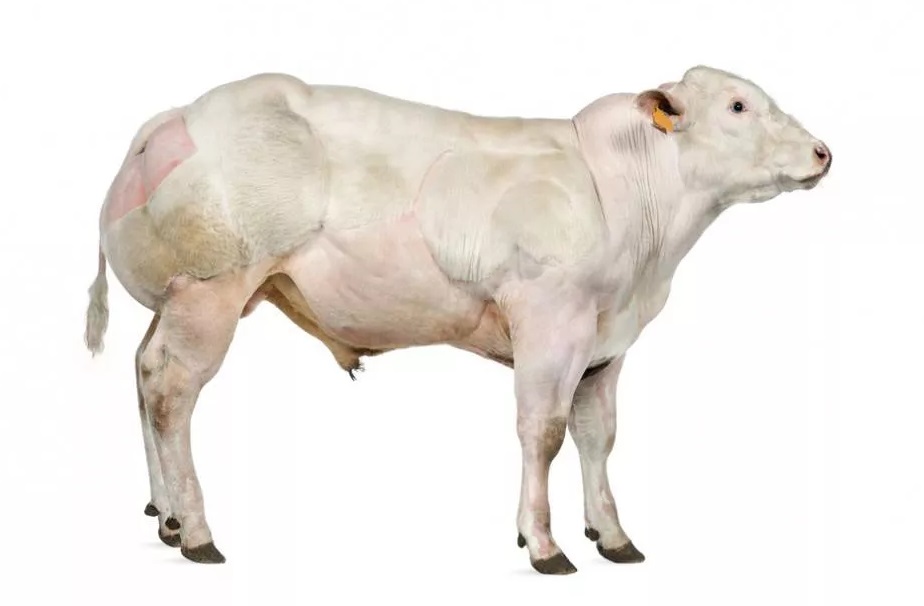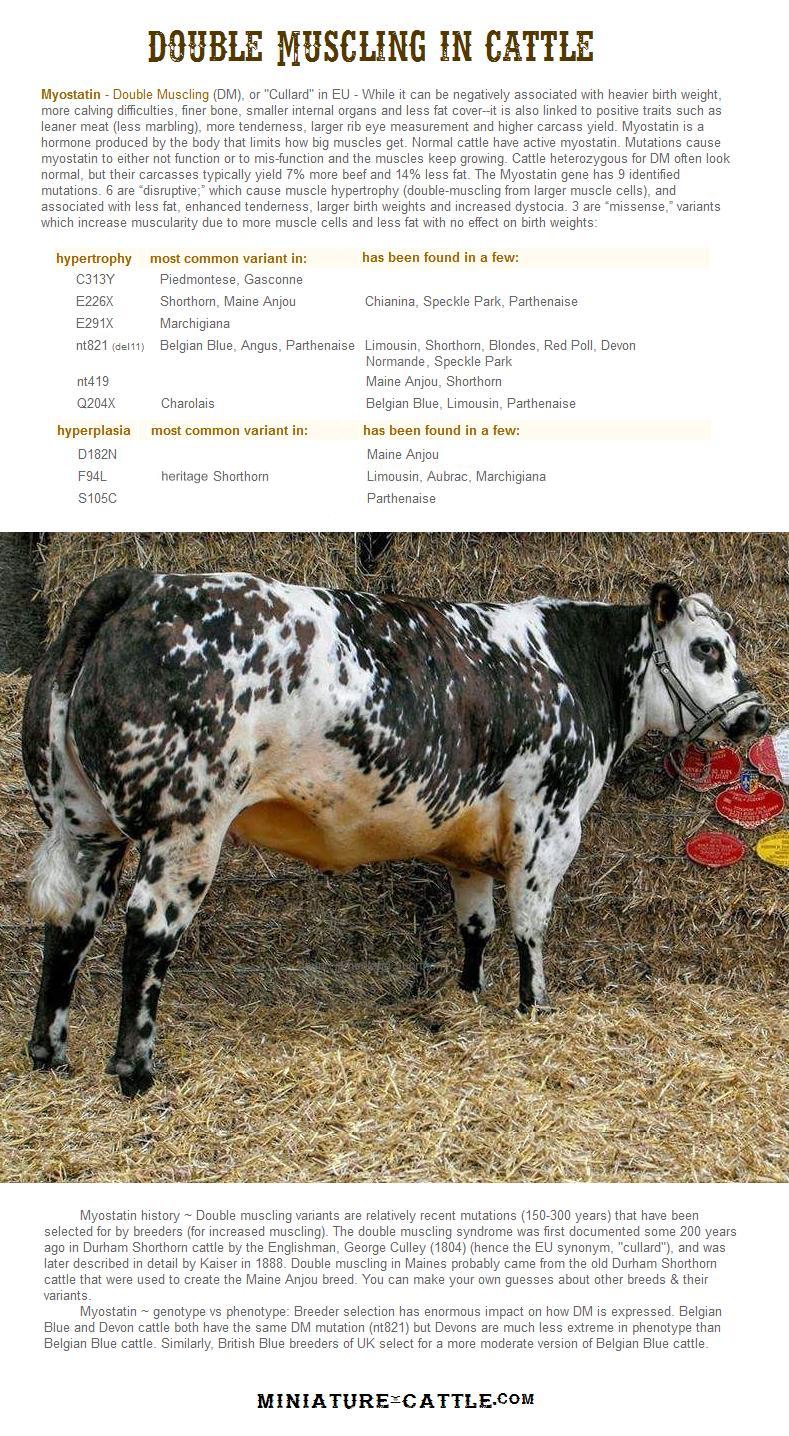
image credit:
Eric Isselee / Shutterstock
Myostatin Mutations
Double Muscling
Myostatin - Double Muscling (DM or MYO). Myostatin mutations appeared relatively recent in history and were propagated by beef breeders selecting for increased muscle. The double muscling syndrome was first described in Durham Shorthorn cattle by the Englishman, George Culley in 1804 (hence today's EU / UK word for DM; "culard" or "cullard"). Normal cattle have active myostatin. MYO mutations reduce or stop normal myostatin protein production, affecting or causing unregulated muscle growth. Different myostatin variants produce different phenotypes, combinations & degree of symptoms. There are both advantages and disadvantages (and great variations in both) to consider when raising DM cattle. The issues to consider include the following:
-
animals with more muscle yielding carcasses with more meat, smaller organs, and finer bone
-
carcass with more muscle to bone ratio: animals with reduced height, bones are shorter, smaller and lighter (more porous), increased fragility
-
minimal DM affect around the neck; increasing towards rear, maximum in hindquarters. This distribution results in a carcass with a higher proportion of "expensive" cuts of meat.
-
increased meat tenderness: less collagen (connective tissue) and /or collagen with changed structure
-
reduced fat cover, reduced marbling, and / or modified fat composition (higher percentage of polyunsaturated fats)
-
increased dystocia in some lines; due to larger calves (larger tongues in newborns may be the first indication)
-
extreme muscle definition, affecting angles in hindquarters, tailset, hocks, and some hampering of movement
-
reduced fertility: later maturing, underdeveloped sex organs, increased embryonic mortality, reduced milk
-
quicker to fatigue, reduced heat tolerance, increased susceptibility to respiratory disease
-
smaller organs (stomach?) post-weaning growth rate slows; this appears to be due to a lower feed intake
-
more efficiency; more pounds gain per pound of food eaten
There are currently 9 DM variants identified in cattle. They are still not well researched or completely understood. Most DM mutations originated in different breeds. Some are dominant and some are recessive; but most display incomplete penetrance, some interact with other genes, and with each other when combined. Selection pressure has dramatically affected their phenotypic expression, which varies between mutations, and can vary remarkably in the same mutation between breeds. Six myostatin variants are “disruptive” mutations, which cause the "double-muscling" effect results from enlarged muscle cells. Three are “missense” mutations, which increase muscularity due to the animal having more muscle cells.
Here is a table of the known DM variants and the breeds they are most often associated with:
| hypertrophy | mutation | possible origin: | but also found in: |
| C313Y | disruptive | Piedmontese | • |
| E226X | disruptive | Shorthorn? | Maine Anjou, Chianina, Speckle Park, Parthenaise |
| E291X | disruptive | Marchigiana | • |
| nt821 |
disruptive | Belgian Blue | South Devon, Blondes, Limousin, Normande, Shorthorn, Speckle Park, Angus |
| nt419 | disruptive | Maine Anjou | Shorthorn |
| Q204X | disruptive | Charolais | Limousin, Belgian Blue, Parthenaise |
| hyperplasia | • | possible origin: | found in a few: |
| D182N | missense | • | Maine Anjou |
| S105C | missense | • | Parthenaise |
| F94L | conservative | heritage Shorthorn | Aubrac, Limousin, Marchigiana |
Between cattle breeds, "...there is not always a clear relationship between the myostatin genotype and its resulting phenotype; for example, Grobet et al. (1998) found some Limousin and Blond d'Aquitaine animals which appeared to have the double muscling phenotype but which on testing had a normal myostatin genotype. Conversely, Smith et al. (2000) observed that not all South Devons with two defective myostatin genes were overtly double-muscled. This caused them to speculate that there must be other genetic factors influencing the expression of the double muscling phenotype. A similar conclusion was reached by Dunner et al (2003), and by researchers at the U.S. Department of Agriculture, Clay Centre, Nebraska (Casas et al., 2001) who, following their analysis of cross-bred progeny sired by double-muscled Belgian Blue and Piedmontese sires, concluded that although the myostatin gene has a considerable effect, other loci with more subtle effects are involved in the expression of the phenotype." ~ Alpha Polled South Devon Cattle, Australia
sharable infographic:

5 that disrupt the protein (nt821, Q204X, E226X, C313Y, nt419) 4 Spanish breeds: 12 French breeds: 2 Belgian breeds: 9 British breeds: 1 Italian breed: |
published online: May 2019
![]()
Homestead & Miniature Cattle Directory
![]()
Homestead Cattle Association
![]()
Homestead & Miniature Cattle Registry
Heritage Cattle Registry
![]()